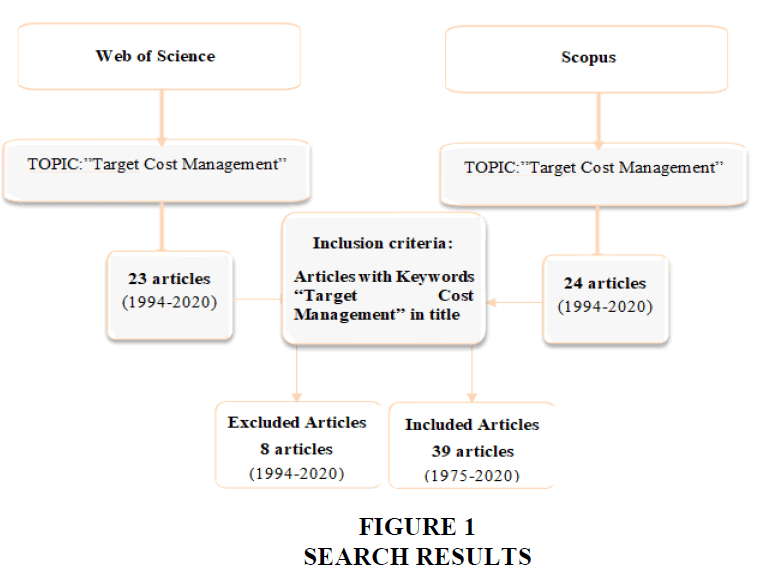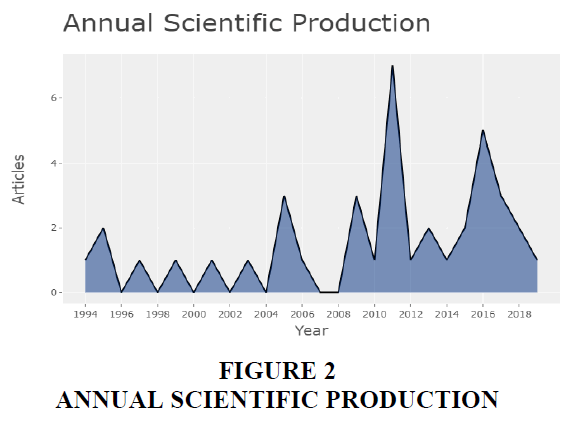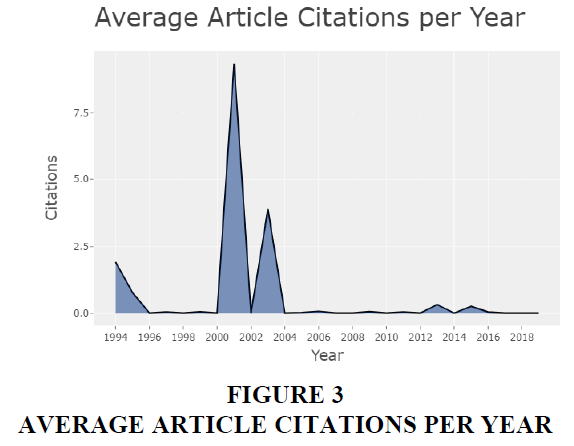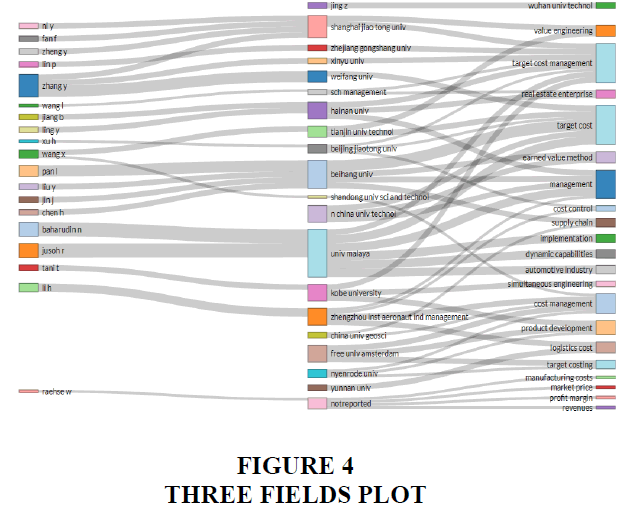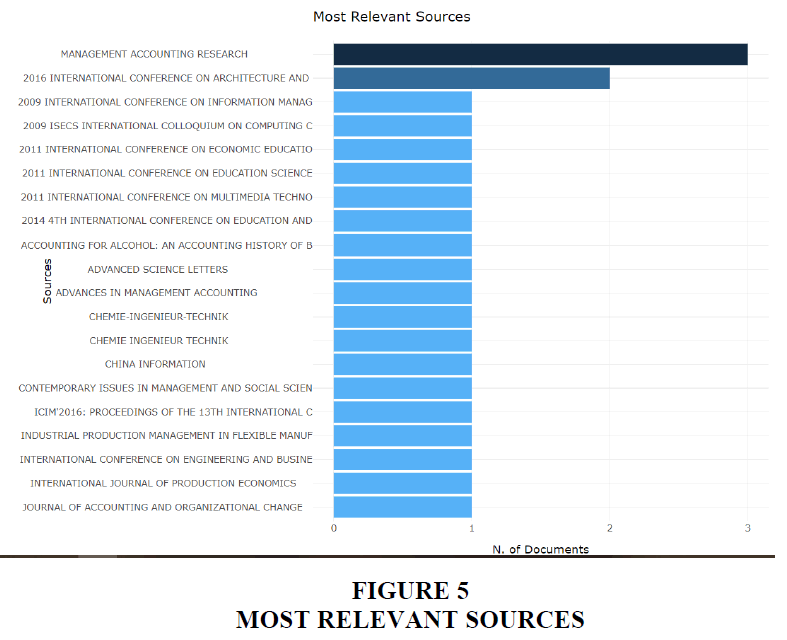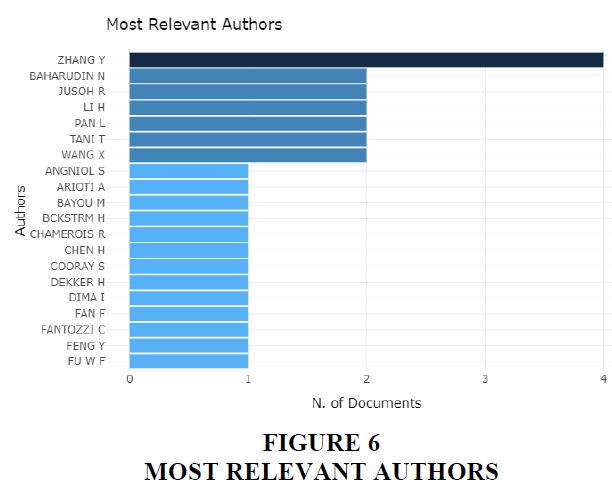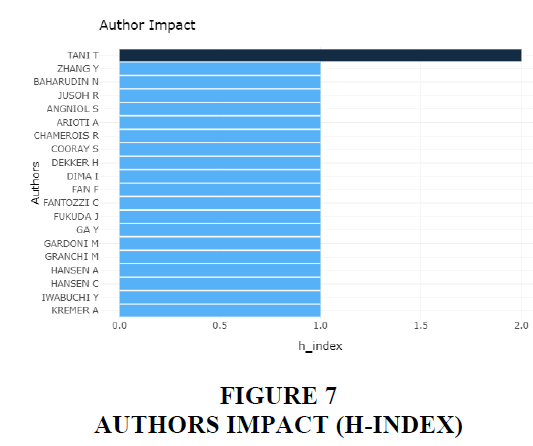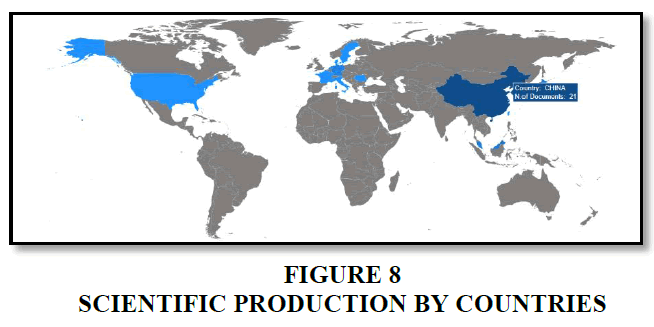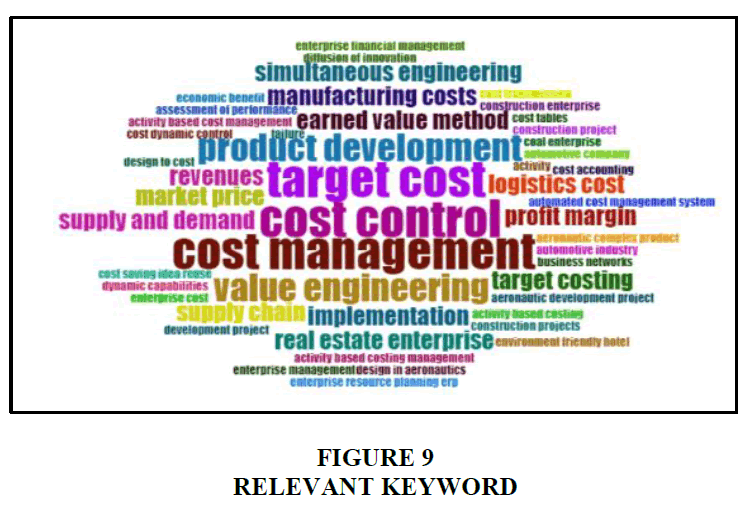Research Article: 2022 Vol: 28 Issue: 1S
A Bibliometric Review of Target Costing Management Using R Bibliometrix
Carmem Leal, University of Trás-os-Montes e Alto Douro (CETRAD)
Cidália Oliveira, University of Minho (NIPE)
Rui Silva, University of Trás-os-Montes e Alto Douro-CETRAD
Citation Information: Silva, R. (2022). A bibliometric review of target costing management using r bibliometrix. Academy of Entrepreneurship Journal, 28(S1), 1-19.
Abstract
Results and contributions: Five clusters were found using bibliographic coupling, namely: Cluster 1: TCM and inter-organisational relationships; Cluster 2: Management accounting leveraging inter and intra-organisational networks; Cluster 3: TCM applications in Japanese companies; Cluster 4: Management control systems and firm performance and Cluster 5: Accounting change. Purpose: TCM has become increasingly important, as there are several organisations that, due to the nature of their business, have a fixed selling price. This means that managers must work efficiently on price drilling to reach a target cost. Considering the growing trend of this pricing philosophy, to provide information that may be useful to guide both managers, in performing target cost implementation, and researchers, in developing this still growing area. Gap: The identified gap was the need to synthesise this important knowledge area, covering this technique, its main characteristics and summarize the contribution of recent studies in this field. Relevance: The achievements of this paper open new avenues for other TCM researchers because knowledge gaps in existing research were identified, leading to future research inspiration. Impact: This might be the first systematic review of TCM research carried out with bibliometric and mapping analysis since 2015. Methodology: This study systematically reviews papers on TCM, extracted from the Web of Science and Scopus databases, applying two bibliometric analyses on the last five years of data: mapping analysis and bibliographic coupling using the software VOSviewer and R Bibliometrix. A total of 39 papers on TCM from the period 1994âÂÂÂ?ÂÂÂ?2020 were analysed. Based on this analysis the most influential authors, articles, journals, institutions, countries, and author collaboration networks were determined.
Keywords
Target Costing Management, Management Control Systems, Firm Performance, Vosviewer, R Bibliometrix.
Introduction
Target costing management is defined according to the strategic objectives of the organisation, considering the targets of markets, customers, and products that the organisation intends to offer (Cooper & Slagmulder, 1999). This technique is an important concept and tool for managing product costs during the design stage (Kato et al., 1995) and to lead effective new product development processes. In this regard, and according to Tani et al. (1994), TCM simultaneously concerns reaching a target cost along with planning, development, and detailed design of new products by using methods such as value engineering. The main motivation for managing costs during product design is that after the product development stage most costs have been “designed” into the product and cannot be (significantly) influenced during production anymore.
TCM is not a recent topic; it emerged at Toyota in 1963 and has spread to other Japanese automobile firms (Kato et al., 1995). According to Tani (1995), the importance of the management of product development for cost reduction and the idea that most costs are fixed in the early stages of production paved the way for TCM. As it focuses on long-term cost management efforts, target costing is considered to be a strategic management accounting system (Guilding et al., 2000; Tani, 1995) that is being increasingly adopted by several leading firms across the world (Ansari et al., 2006).
The performed investigation showed that most of the research to date focuses on describing and advocating the use of target costing, aimed at practitioner audiences and descriptive in nature. Considering this, a systematic approach was adopted to conduct the literature review; so, the subject of analysis encapsulates scientific articles about TCM published in either the Web of Science (WoS) or Scopus (SCO) databases. The aim of this paper is to carry out a bibliometric analysis on target costing management. To accomplish this, three research questions were identified. First, it is clear the scarcity of reviews pertaining to TCM, so, we define the first research question as:
RQ1: What are the topics related to TCM in research?
According to Sackett and Larson Jr (1990) and Prashar and Sunder (2020) for the advancement of management research it is essential to evaluate the methods and techniques previously used. Thus, the second research question was:
RQ2: What research methods are used by scholars to study TCM?
In an attempt to identify gaps in the literature, with the aim of uncovering future research opportunities, in line with the research objective of this paper, it is important to know what has been written about TCM so far. Subsequently, the final research question is:
RQ3: What are the research gaps and potential future research directions for TCM?
To address these questions, the WoS and SCO databases have been used to collect articles that fit the research objectives. Then, a systematic literature review of the current state-of-the-art literature on TCM to explore understanding of the current research situation was provided.
The remainder of this paper is organised as follows: Section 2 describes the state of art of Target Costing and Target Costing Management. It then provides a descriptive analysis to address the RQs, followed by the synthesis of findings through content analysis to identify emerging topics on TCM. The data, descriptive statistics, and research design are discussed in Section 4. From there, the paper provides a research agenda by providing research gaps and directions for the purpose of future research.
Theoretical Background: The State of Art
Target Costing
TC was developed as a planning and cost management tool in 1963 at Toyota. Afterwards, this tool was implemented by other organisations such as Nippon Electric Company (NEC), Sony, Nissan, Sharp, and Hewlett-Packard (HP). Given the origin of this tool, namely a business environment, it was especially required by consultants and managers (Ishikawa & Sakurai, 2016).
Due to the situation in Japan after the Second World War, TC emerged as a follower of the value engineering tool (Ansari & Bell, 1997). As is known, it is crucial to know the productive details of the products, especially in times of crisis. In the 1940s, resources were scarce and required a more efficient management, such as the search for alternative raw materials, which prompted organisations to redesign products in order to be able to produce them without compromising its essential characteristics. Japanese industry faced, among other challenges, a growing demand in the western market, which forced Japanese organisations to adapt to market conditions with regard to the market price and the range of products.
Target costing is primarily implemented in Japan and in countries with the same cultural characteristics (South Korea, Taiwan) and, in view of the recognised final gains, the first implementations were registered in Europe and in the United States at the end of the 1980s. According to Dekker & Smidt (2003), this tool has an increasing practical applicability in Germany, whereas in other European countries, particularly Mediterranean countries, only a small group of firms (Ciambotti, 2001) have adopted it.
As previously referred, TC is based on Japanese cost management practices that detail the value of products and services. In addition, it enables an analysis of cost details according to the requirements and constraints of the market. Thus, this tool is innovative from a competitive perspective, since the selling price is composed of the production cost plus the respective profit margin ( Navissi & Sridharan, 2017). Organisations that implement this tool are those that have their sales price fixed in the first instance. Subsequently, and after analysing the functionalities and characteristics of the products, the structure of variable and fixed costs is adapted to achieve the defined sales price (Monden & Hamada, 1991). According to Tanaka (1993), TC is a pricing method developed as a result of an extremely competitive environment, which specifies a better estimate of the cost of the work to be carried out (Chan et al., 2011). Following that idea, Ansari et al. (2006) stated that “target costing is a system of profit planning and cost management that ensures that new products and services meet market determined price and financial return.” Cooper & Slagmulder (1999) have defined TC as a costing technique to manage a firm’s future profits by explicitly including target costs in the product development process; they also noted that it is a complex process that imposes discipline to reach the cost goal without sacrificing functionality and quality. Dekker & Smidt (2003) emphasised the importance of reverse costing to TC; Cooper & Slagmulder (1999) have referred to reverse costing as “market driven-costing”, an essential characteristic of target costing systems. Lockamy and Smith (2000) see target costing as a means for integrating customer feedback in the supply chain through the development of a total cost structure reflective of current customer requirements. Following this reasoning, Ellram (2006) summarises TCM “as the process which considers the voice of the customer, incorporates earlier supplier involvement and concurrent engineering, utilizes cross-functional teams, and focuses on creating a good or service that is both desirable and affordable to the customer and profitable to the producing organisation.”
Target costing management
Target costing management is defined according to the strategic objectives of the organisation, considering the targets of markets, customers, and products that the organisation intends to offer (Robin Cooper & Slagmulder, 1999). TCM places great emphasis on decision-making during the product development process, defining what kind of products are developed and how they can be produced (Yasukata et al., 2013). In this process, functional analysis plays a significant role, insofar as it improves organisational competitive edge (Mouritsen et al., 2001).
Yasukata et al. (2013) follow this line of reasoning, stating that TCM places great emphasis on the allocation of considerable organisational resources to the product development process, understanding that those decisions will have a substantial impact on the costs accrued and measured during the production process.
After defining the strategy, implementation work is carried out by multidisciplinary teams in order to put this tool in place. As the implementation is a crucial step, the team should include professionals of various areas, such as planning, marketing, engineering, finance, purchasing, and production. For example, product designers need large amounts of information on customer needs, manufacturability at plants, or material availability; upon analysing that information, they make decisions regarding what kind of product they will develop and how they will produce it (Ansari & Bell, 1997; Yasukata et al., 2013).
Bearing in mind the very complex and split process, Per?evi? et al. (2015) deduce eight different characteristics attributed to TCM based on the early Japanese case studies: 1) The target sales price is set during product planning, in a market-oriented way; 2) The target profit margin is determined during product planning, based on the strategic profit plan; 3) The target cost is set before new product development actually starts, based on either the subtraction or the addition method; 4) The target cost is subdivided into target costs for functions, subassemblies, cost items, designers or suppliers; 5) Target costing requires cross-functional co-operation; 6) Detailed cost information is provided to support cost reduction; 7) The cost level of the future product (drifting cost) is compared with its target cost at different points during new product development; 8) The general rule that “the target cost can never be exceeded” is established. These characteristics of TCM indicate that is a tool aimed at cost management and profit planning, focusing on customers’ needs and product design.
Some studies applied to non-Japanese companies revealed some differences in TCM practices (Carr & Ng, 1995; Ellram, 1999, 2006); however, these may be a common phenomenon as posited by contingency theory since the implementation of any new management accounting system needs to adapt to its environment (Carenzo & Turolla, 2010; Drury, 2006). Target price is very often introduced in processes of a new version launch, in which some of the main components are kept and just some small components are changed, or, alternatively, the whole product design and R&D is changed (Filomena et al., 2009). Several times, managers face the need to re-allocate the standard cost and the definition of a sales price, as these are fundamental characteristics of value engineering (Burns, Quinn, Warren, & Oliveira, 2013). Managers know that if the actual costs are above the target and no reduction of costs is allowed, these products or projects should end production to avoid further losses (Burns et al., 2013).
Success Factors of Target Costing Management Implementation
Target costing requires special attention in order to be successfully implemented. Given that cost reduction is a very complex process, the implementation is usually done by a multidisciplinary process (CIMA, 2005). Considering the innumerable steps, the focus on the customer stands out, in order to meet their expectations, in accordance with the required quality and the related costs (Cooper & Chew, 1996).
Multipurpose teams have a strong impact on the team's collective knowledge and, consequently, on their actions (Gagne & Discenza, 1995). A large proportion of a product's costs is related to raw material, so the suppliers’ involvement is provided to reach the target cost (Ansari & Bell, 1997). All in all, this process consists of an interactive process, as TC is not an exact science, but based on forecasted information, and evolves from an early stage to a later stage (Cooper & Chew, 1996). Because target costing is defined based on predictions, sometimes the targets need to be updated due to the interactivity of its components, namely when the price of one component changes (Cooper & Chew, 1996).
By applying target costing it is possible that only profitable projects are launched on the market, in order to foster competitiveness and customer satisfaction (Cooper & Slagmulder, 1999). Cost reduction is relevant from an early stage of product development and should be highlighted. In order to obtain the full scope of costs, maintenance and repair costs should be incorporated to allow an efficient cost reduction. Thus, the target costing team comprises managers from different areas: (i) Management: responsible for defining the target profit; (ii) Purchasing: analysing components and negotiating alternatives; (iii) Financial Area: a coordination role, managing the allocation of target costs to the individual components; (iv) Sales and Distribution Planning: defining the target price and successively negotiating with customers; (v) Engineering: using techniques such as value engineering to identify cost reductions; (vi) Production: searching for improvements or changes in the production process to reduce production costs.
Lockamy and Smith (2000) highlight that higher sustainability, namely competitiveness and profitability, is performed based on the selection of adequate target costing parameters in accordance with the customers’ requirements and with the supply chain’s provision capacity. According to Cooper and Slagmulder (1999), the factors that apparently help shape the market-driven costing portion of the target costing process include the intensity of competition and the nature of the customer. These two factors help determine the magnitude of the benefits derived from target costing. In fact, TCM practices are being applied in industries characterised by high levels of competition, demanding continuous reductions of costs while maintaining the products’ standards of quality.
Failure Factors of Target Costing Implementation
Despite the already known advantages of implementing TC (Ansari et al., 2006; Cooper & Slagmulder, 2004), there are also some limitations or failure factors that limit this deployment. One of the reasons why some of those haven’t been overcome yet might be related to the fact that, even though the tool was already developed in the late 1960s, there is still a lack of research in this area (Ansari et al., 2006). Kato et al. (1995) list some limitations, like lead-time, Focus customer, Organisational conflicts. Lead-time: the afforded time to update the tool is extremely long, due to the process of updating all the new components or products, which may cause a very long lead-time for the product launch. In order to avoid this long process, Kato et al. (1995) suggest that managers must balance cost factors and quality factors in order to select the changes to be updated, thus guaranteeing the required quality within the defined cost parameters. Demotivation factors: several of the required changes are pushed to occur in a very short time span, which may cause a feeling of frustration and demotivation. Bearing in mind that the project team is usually comprised of members of several sections in order to provide a whole organisational view, the information and subsequent implementation flow is extremely time-consuming. Furthermore, as each member has their own perception and procedure, points of view may conflict and it sometimes takes long to reach consensuses among project members. In these cases, the process is even longer, as all members should have an active voice in regards to product launches or even target definition. These long processes may cause the demotivation of members, as each one of them is looking forward to rapidly determine the price target and assess the results. Focus -Customer the customer’s focus is recognised as having positive impact on organisations. However, that focus may also cause difficulties with the implementation of target costing if it is exaggerated or uncontrolled. Considering that all changes in the product structure need to be reviewed when a new version or product is launched, extreme focus may cause a biasing internal functioning of the process. Managers should, in a preliminary phase, evaluate the financial impact of the component change, namely a new launch, on the entire value chain. Organisational conflicts every time a new version or project is launched, new, adjusted targets need to be defined, for all the components, from top to bottom, and split by type (Ansari & Bell, 1997; Kato et al., 1995). It is known that during the development phase, while launching a new variant or product, several one-time effect costs are registered and these must be implicitly integrated in the cost structure. Bearing these exceptional development costs in mind, managers need to identify further possibilities to reduce costs, so as to compensate for the development costs.
In addition, the financial investment in research and development regarding new products or components, especially in the first years of development, is very high. Furthermore, organisations usually register high costs without having their pay-back in the same period. Sometimes, after having started production, organisations also need to reduce or review the parameters of quality, as managers are forced to reduce costs, which will naturally impact the final component or product.
Furthermore, as there is no standard tool to implement target costing, it needs to fit into the specific parameters of each organisation, i.e. components, sales price, and margins. This specific configuration of the management tool, namely to adjust it to the product development, is time-consuming, as managers must allocate each target costing of every single component.
It is possible to see that the main difficulties related to the management process (tool limitations) are not technical, but mostly associated with people, process, and customer relationship. The understanding of this fact further encouraged carrying out this investigation.
Methodology
To address the research questions, a systematic literature review (Transfield et al., 2003) of the extant literature on TCM was performed. Fundamentally, knowledge advancement must be built on prior existing work. Reay et al. (2009) recognised literature reviews as a higher level of research evidence amongst other empirical and field testimonies because of the element of structured analysis-synthesis that underpins the reviewed articles. By reviewing relevant literature, we understand the breadth and depth of the existing body of work and identify gaps to explore. Systematic reviews have become a fundamental scientific activity, and, hence, are essential for the literature (Reay et al., 2009; Tranfield et al., 2003).
Systematic literature review
Systematic Literature Review (SLR) has been established and practiced in the field of medical sciences because of the need to integrate the results of clinical studies. More recently, especially with the digitisation of scientific publications and the proliferation of quality and impact metrics, SLR has gained popularity within the social sciences. Nevertheless, the application of SLR in the social sciences field requires some adaptations regarding the statistical integration of results. Systematic Review works require the application of very clear and explicit methodological procedures. According to Xiao & Watson (2019), “a successful review involves three major stages: planning the review, conducting the review, and reporting the review.” These authors suggest eight common steps for any SLR: (1) formulating the research problem; (2) developing and validating the review protocol; (3) searching the literature; (4) screening for inclusion; (5) assessing quality; (6) extracting data; (7) analysing and synthesising data; and (8) reporting the findings.
Data Collection
The literature search yielded 47 article results, 8 of which were duplicates. The titles and abstracts were reviewed and screened for inclusion and exclusion criteria. The following inclusion criteria were established: (1) articles with the keywords “target cost management” in title. The 47 articles that were selected in WoS and SCO were published between 1994 and 2020. After this initial screening, 8 articles were excluded and the first instance of full-text review for the remaining 39 papers was conducted. In Figure 1, the research layout and results that led to the final set of articles were summarised.
Procedures Applied in Content Analyses
The use of bibliometrics has been growing in popularity. It is suitable for science mapping at a time when the emphasis on empirical contributions is producing voluminous, fragmented, and controversial research streams (Aria & Cuccurullo, 2017). According to Aria and Cuccurullo (2017), “the existence of substantial, effective statistical algorithms, access to high-quality numerical routines, and integrated data visualization tools are perhaps the strongest qualities to prefer R to other languages for scientific computation.” Several recent studies recognised the use of bibliometrics capable to perform clustering in order to explore trends and grouping of literature in an graphical outlook, based on the frequency of words (Pollack & Adler, 2015; Prashar, 2020) The R Bibliometrix (Aria & Cuccurullo, 2017) package was used to perform bibliometric analysis and build data matrices for co-citation, coupling, scientific collaboration analysis and co-word analysis and VOSviewer (van Eck & Waltman, 2010) in order to create data clusters from analysed articles.
Along this research the co-occurrence of networks based on keywords was identified to address RQ1. In order to achieve the research results VOSviewer software, was selected, mining the datasets and selecting keywords, in order to describe a research papers related to the selected edge. VOSviewer software achieves the original data source from the WoS and SCO databases, covering the bibliographic information of the articles without any modifications. Furthermore, density-based clustering was fulfilled as method and association-based normalisation algorithm. A threshold, of 5 for keywords analysis, required by the software, was performed, representing the minimum number of keywords to be gathered in a paper. The keywords that met the requirements of the selected threshold were then mapped and clustered, enabling the co-occurrence networks analysis. (Prashar, 2020). Consequently, all abstracts, literature review and final considerations were read. Based on this review a summary document was created to gather the most relevant information extracted from those sections of each article. Lastly, the contents were split based on its main constructs, to issue an explanation of the main theoretical approaches of each cluster, so as the outcomes that have been identified. (Rocha et al., 2021)
Results
Cluster Analysis
Cluster 1: TCM and inter-organisational relationships
The major cluster of the keywords network deals with TCM and inter-organisational relationships. Papers included in this cluster report that cost management needs to adapt to the new technological area, where network relationships are crucial, as there is still a gap between the supplier’s cost information and the customer’s information. Organisations need to identify internally their operational costs, for internal knowledge, and then select the costs to share with cooperating firms and the costs that might be shared in networks (Kulmala et al., 2002). Planning and control are performed across organisational borders, so that different forms of corporate alliances and wider business networks need to be performed (Tomkins, 2001). In this wide sense, beyond borders, management control structures that are able to integrate and follow transaction risks may moderate performance constraints (Anderson & Dekker, 2005).
Bearing in mind the relevance of inter-firm contexts, several fields of management accounting have not been completely explored, and that can influence control choices. Trust is crucial in supply chain relationships, as collaborating firms “open their books” and show management accounting information, so as to promote a positive relation with task interdependence (Caglio & Ditillo, 2008). Open-book accounting (OBA) is a recognised tool to develop interdependencies across organisational boundaries, namely for alignment and managing conflicts between parts. OBA is viewed as a key instrument for strengthening supplier relationship, new resource interlinkages, and organisational interfaces (Alenius et al., 2015). Seal et al. (1999) performed an action research on two non-Japanese U.K. manufacturing companies to identify the role of information by sharing R&D and strategic components. Considering that, in these organisations, the material costs correspond to 80%, the role of management accounting is relevant to develop cost and performance technologies.
Open-book accounting promotes the cost efficiency of supply chains and assures trust in customer-supplier relationships. Nevertheless, some OBA strategies fail due to several reasons, such as the degree of competition, firm size, type of production, and network (Kajüter &; Kulmala, 2005). Target costing, or the so-called OBA, correlates positively with the intensity of competition, but diminishes when perceived environmental uncertainty grows (Ax et al., 2008). Management accounting may be a basis for governance in inter-organisational relationships. Several control mechanisms are used in organisational alliances to motivate and coordinate (Henri Dekker, 2004). In order to achieve deeper knowledge regarding buyer-seller relationship in the automotive industry, Agndal & Nilsson (2008) have identified seventeen different decision making processes. The OBA might be a basis for decision-making and of advantage not just for suppliers, as it also promotes a collaborative environment. Due to the importance of controlling interfirm relations, Van der Meer-Kooistra & Vosselman (2000) built a model of management control structure for interfirm relationship. The results of the case research, which focused on outsourcing relationships, pointed out the relevance of strategic, cultural, and historical factors for control structures. By combining law, economics and organisations, an instructive overview of organisations and their contractual relations can be performed (Williamson, 2010).
Cluster 2: Management accounting leveraging inter and intra-organisational networks
Bearing in mind the current turbulent environment, markets are not simply expanding, but continuously emerging and re-emerging (Callon, 1998). Knowing this, accounting nowadays aims to guide organisations in a manageable and efficient way (Graham, 2010). The second cluster of this research includes papers that analyse how management accounting leverages inter and intra-organisational networks.
Current research on management accounting is concerned with the nature of management accounting practice (Scapens, 1990). Based on single case studies and semi-structured interviews, Ahrens & Chapman (2004) confirm that management pursued the objective of efficiency and flexibility by using management control systems. Management control systems are of increasing importance for performance measurement (Chua & Mahama, 2007). Accounting figures are the results of the relationships among partners and alliances (Chua & Mahama, 2007); following the path of the applicability of accounting, inter-organisational and target cost management create new possibilities for the management’s interference (J. Mouritsen et al., 2001). Management accounting adds value to organisations by mediating between innovation concerns and firm-wide concerns (Jan Mouritsen et al., 2009). Accounting serves both to integrate entities which are internal and external to the focal firm and to fragment focal firms. Thrane & Hald (2006) confirmed in their research the dynamics of integration and fragmentation within a supply chain.
Cluster 3: TCM applications in Japanese companies
This cluster includes eight papers addressing TCM and value engineering applications in Japanese firms. This might be explained by more than 30 years of target costing applications in Japanese industry (Kato et al., 1995). In this sense, the papers in this third cluster explore some case studies, analysing results and suggesting new possibilities on the path of management accounting change.
Cluster 4: Management control systems and firm performance
Otley argues that the reality of management control has changed over the years, as business reality is different nowadays ( Otley, 1994). It is known that accounting control doesn’t play a particular role in planning and control function, but it is relevant to rationalise and supplement other notorious elements of the control package (Hayes &; Abernathy, 1980). Product development is recognised as a highly relevant source of competitive advantage; so, the importance of target costing as a management control tool is currently greater (Davila &; Wouters, 2004; Davila, 2000). The comprehension and interlinkage between strategy and control systems is important in management accounting (Simons, 1987). Top management support and the use of ABCM (Activity-Based Cost Management) data are determiners of success impacting performance evaluation and incentive systems (Foster & Swenson, 1997).
Cluster 5: Accounting change
The fifth cluster consists of four papers and is the smallest of the clusters found. The papers included focus on changes in accounting practices, on resistance to change, and on organisational change. They are mostly theoretical articles and do not speak directly about TCM. Despite this, when addressing organisational changes and accounting, they are indirectly related to TCM, since this technique can be considered something transformational within cost accounting. Burns (2000) indicates that accounting goes through a powerful and dynamic process with several challenging insights. Quattrone and Hopper (2001) follow this path when they attest that the pluralism of organisational change leads accounting managers to describe several possible courses of actions instead of limiting themselves to one single possibility. These two investigations support Scapens & Roberts (1993), who reported that organisational changes have attracted special attention among managers. While transforming organisational ambient, as new systems, a notorious barrier and resistance between the language used in production and accounting is identified.
Mapping and Network Scientific Analysis
Main information about the collection
After conducting the search in the WoS and SCO databases, applying the refinement criteria, excluding duplicates, and placing the database in the R Bibliometrix software, the final detailed information that would be subject of scientific analysis was obtained (Table 1).
| Table 1 Network Scientific Analysis | |
| Description | Results |
| MAIN INFORMATION ABOUT DATA | |
| Timespan | 1994:2020 |
| Sources (Journals, Books, etc) | 36 |
| Documents | 39 |
| Average years from publication | 11,1 |
| Average citations per documents | 9,41 |
| Average citations per year per doc | 0,4541 |
| References | 585 |
| DOCUMENT TYPES | |
| article | 13 |
| book chapter | 2 |
| conference paper | 5 |
| proceedings paper | 18 |
| review | 1 |
| DOCUMENT CONTENTS | |
| Keywords Plus (ID) | 97 |
| Author's Keywords (DE) | 102 |
| AUTHORS | |
| Authors | 75 |
| Author Appearances | 84 |
| Authors of single-authored documents | 13 |
| Authors of multi-authored documents | 62 |
| AUTHORS COLLABORATION | |
| Single-authored documents | 16 |
| Documents per Author | 0,52 |
| Authors per Document | 1,92 |
| Co-Authors per Documents | 2,15 |
| Collaboration Index | 2,7 |
Most of the papers on TCM were presented in conferences, rather than published in articles. This may demonstrate a path that still needs to be covered on this topic.
Annual scientific production
In the period between 1994 and 2020, which contains the final output (N=39), we can see the annual number of publications after applying exclusion criteria (Figure 2). Analysing all of the research outputs resulting from the articles published over the 1994-2020 period, we can see a significant growth. Since 2004, the number of publications has grown exponentially compared to the previous 10 years. Between 2008 and 2018, the number of publications spiked significantly, reflecting the underlying trend of rising academic coverage (Figure 2).
Average Article Citations per Year
Regarding the average number of citations of each article per year, we found that the years presenting the highest volume of citations were those between 2000 and 2004, with very low values in the remaining years, except for the period between 2012 and 2016. This shows that the topic has not been widely addressed by researchers, hence the existence of a reduced number of citations of works in this area of knowledge (Figure 3).
Three fields plot
In Three Fields Plot (Figure 4) the connection between the authors and their respective research topics are visible, with strong associations pertaining to two main authors (Baharudin and Jusoh) whose research work is a reference in this area of knowledge (Figure 4).
Most relevant journals
Concerning the most relevant journals in this area, Accounting Management Research, a first quartile journal with an impact factor of 2.17 (Figure 5), stands out. This aims to serve as a vehicle for publishing original research in the field of accounting management. Its contributions include case studies, analytical modelling, scholarly papers, distinguished review articles, comments, and notes. It provides an international forum for the dissemination of research, with papers written by prestigious international authors discussing and analysing management accounting in many different parts of the world (Scimago Journal & Country Rank, 2020). Accounting Management Research is also the most cited journal with the greatest impact factor in this area of knowledge.
Most relevant authors
The outputs showed that only one author has four or more publications, followed by several authors with three (Figure 6). These authors mainly investigate the subjects of “target costing”, "target cost management" and "value engineering" (Figure 6).
Regarding h index, which measures the scientific and academic impact of authors and of their research, only one with a value of h-index=2 stands out, with the rest standing at 1. Research carried out by TANI in 1994 and 1995 has allowed him to have a great impact in this area of knowledge until today. On the other hand, once again, ZHANG stands out as another expert in this area of research (Figure 7).
Country scientific production
Concerning the countries with the highest scientific productivity in this area, China stands out, followed by Japan and Malaysia, all belonging to the Asian continent (Figure 8).
Most important research topics
Finally, Figure 9 presents the most-addressed topics in TCM investigations. The outputs revealed that the words “target costs”, “costs” and “cost management” were the most used, verifying that the keywords that enabled this mapping of the literature are the most indicated to obtain better outputs from the study, analysis, and understanding of this area of knowledge.
Conclusion
Bearing in mind the aim of this paper, namely to provide a general and updated picture of target cost management, this research was performed based on the last decades review by using bibliometric indicators. The basis of the literature review was performed based on influential scientific research platforms, namely WoS and Scopus. Based on this review the main contribution of this paper is grounded on modern bibliometric tools to provide results that take into account different indicators that are used in the literature. The majority of the most-cited papers are published in Management Accounting Research, being one of the most influential journal in the field, based on its interdisciplinarity, so as a strong connection between accounting, management and economics.
China stands out in this research field, as a dominant country having a very strong position in all the top journals. Furthermore, it needs to be highlighted that almost all top authors shown in the above are from China and other Asian countries. These authors have published a great part of the highly-cited papers in TCM. This highly positioning might be related to the fact that target cost management has been primarily implemented in Japan. So, some Asian countries lead a kind of monopoly in this research field. Beside the notorious contribution of Asian countries on this ground, also the USA, Canada and some European countries, also bear significant positions in this domain demonstrating remarkable research results.
This research shows main contributions as it provides a general overview of the state-of-the-art in target accounting management research based on bibliometric research. Based on this research, most noteworthy research in this area might be stressed out, relying on some key indicators, including number of papers, citations, so as, the h-index.
Through bibliographic coupling, five clearly distinct clusters were identified; the scientific characterisation (disciplinary affiliation, methodological approaches, and prevailing managerial themes) of each cluster is also relatively clear. This is evident in the case of the third cluster, referring to TCM applications in Japanese firms. The clusters could be utilised as a guide for young researchers to gain further insight regarding the emerging areas of research in the context of target cost management. Besides, they allow the definition of detailed frameworks that, from the bibliographic references common to the different contributions, can be traced back to even the affiliation of the individual scholars.
However, several limitations that should be considered. First, the analysis aims to be informative, to identify some very relevant research in the field. Though, since this study is based on the WoS and Scopus, other significant research that is not collected in these databases is not included in this study. For instance, some influential authors do not publish many papers, or they do not receive many citations due to their specific topics; another factor is non-English-speaking countries that have shown very weak results, but have perhaps published excellent research results in their own languages. Second, the information was classified, so, several rankings were presented, even not being official, these aimed to be informative, based on the bibliometric data found in the WoS. Many important issues are very difficult to quantify in the evaluation of research, including involvement in journals, conferences, promotion of research worldwide and many other related matters. Therefore, this paper provides general information that may be useful to understand the field, but many other issues should be taken into account in order to get a complete picture of the state-of-the-art.
Future research should conduct multiple case studies in various industries to understand TCM practices in the Portuguese context. Also, and since TCM is a dynamic process, how the TCM implementation process evolves over time within the same organisation could be an interesting topic to explore. Fundamentally, this study indicates that more research is needed in order to prove if target cost management has contributed to management accounting change as some authors have predicted.
References
Anderson, S.W., & Dekker, H.C. (2005). Management control for market transactions: The relation between transaction characteristics, incomplete contract design, and subsequent performance. Management Science, 51(12), 1734–1752.
Ansari, S., Bell, J., & Okano, H. (2006). Target costing: Uncharted research territory. Handbooks of Management Accounting Research, 2, 507–530.
Ansari, S.L., & Bell, J. (1997). Target costing: the next frontier in strategic cost management. Irwin Professional Publishing.
Aria, M., & Cuccurullo, C. (2017). bibliometrix: An R-tool for comprehensive science mapping analysis. Journal of Informetrics, 11(4), 959–975.
Burns, J., Quinn, M., Warren, L., & Oliveira, J. (2013). Management Accounting. McGraw-Hill Higher Education.
Burns, John. (2000). The dynamics of accounting change. Accountabilty Journal, 13(5), 566–596.
Caglio, A., & Ditillo, A. (2008). A review and discussion of management control in inter-firm relationships: Achievements and future directions. In Accounting, Organizations and Society (Vol. 33, Issues 7–8). Elsevier Ltd.
Callon, M. (1998). An Essay on Framing and Overflowing: Economic Externalities Revisited by Sociology. The Sociological Review, 46(1_suppl), 244–269.
Chan, D. W. M., Chan, A. P. C., Lam, P. T. I., & Wong, J. M. W. (2011). An empirical survey of the motives and benefits of adopting guaranteed maximum price and target cost contracts in construction. International Journal of Project Management, 29(5), 577–590. https://doi.org/10.1016/j.ijproman.2010.04.002
Ciambotti, M. (2001). L’influenza dei fattori culturali sul controllo manageriale. Un quadro d’analisi tra aspettative e conferme empiriche (Vol. 1). LINT.
CIMA. (2005). Target costing in the NHS Reforming the NHS from within. In CIMA Discussion Paper (Issue October).
Cooper, R., & Chew, W.B. (1996). Control tomorrow’s costs through today’s designs. Harvard Business Review, 74(1), 88–97.
Cooper, Robin, & Slagmulder, R. (1999). Develop profitable new products with target costing. MIT Sloan Management Review, 40(4), 23.
Davila, A., & Wouters, M. (2004). Designing cost-competitive technology products through cost management. Accounting Horizons, 18(1), 13–26.
Davila, T. (2000). An empirical study on the drivers of management control systems’ design in new product development. Accounting, Organizations and Society, 25(4–5), 383–409.
Dekker, H. C., & Smidt, P. (2003). A survey of the adoption and use of target costing in Dutch firms. 84, 293–305. https://doi.org/10.1016/S0925-5273(02)00450-4
Dekker, Henri C. (2004). Control of inter-organizational relationships: Evidence on appropriation concerns and coordination requirements. Accounting, Organizations and Society, 29(1), 27–49. https://doi.org/10.1016/S0361-3682(02)00056-9
Drury, C. (2006). Cost and management accounting: an introduction. Cengage Learning EMEA.
Ellram, L. M. (1999). The role of supply management in target costing. Center for Advanced Purchasing Studies.
Ellram, L.M. (2006). The implementation of target costing in the United States: theory versus practice. Journal of Supply Chain Management, 42(1), 13–26.
Foster, G., & Swenson, D. W. (1997). Measuring the success of activity-based cost management and its determinants. Journal of Management Accounting Research, 9, 109–142.
Gagne, M.L., & Discenza, R. (1995). Target costing. Journal of Business & Industrial Marketing.
Guilding, C., Cravens, K. S., & Tayles, M. (2000). An international comparison of strategic management accounting practices. Management Accounting Research, 11(1), 113–135.
Hayes, R. H., & Abernathy, W. (1980). Managing our way to economic decline. Harvard Business Review, 58(4), 67–77.
Ishikawa, T., & Sakurai, K. (2016). A Study of Security Management with Cyber Insurance. Proceedings of the 10th International Conference on Ubiquitous Information Management and Communication - IMCOM ’16, 1–6.
Kato, Y., Boer, G., & Chow, C. W. (1995). Target costing: an integrative management process. Journal of Cost Management, 9(1), 39–51.
Kulmala, H. I., Paranko, J., & Uusi-Rauva, E. (2002). The role of cost management in network relationships. International Journal of Production Economics, 79(1), 33–43.
Lockamy, A., & Smith, W. I. (2000). Target costing for supply chain management: criteria and selection. Industrial Management & Data Systems.
Monden, Y., & Hamada, K. (1991). Target costing and kaizen costing in Japanese automobile companies. Journal of Management Accounting Research, 3(1), 16–34.
Mouritsen, J., Hansen, A., & Hansen, C. (2001). Inter-organizational controls and organizational competencies: Episodes around target cost management/functional analysis and open book accounting. Management Accounting Research, 12(2), 221–244.
Navissi, F., & Sridharan, V. G. (2017). Determinants of target costing adoption: a research note. Journal of Management Accounting Research, 29(1), 67–77.
Otley, D. (1994). Management control in contemporary organizations: towards a wider framework. Management Accounting Research, 5, 289–299.
Per?evi?, H., Hladika, M., & Mi?in, M. (2015). Integrated Application of the Target Co-sting and Life Cycle Costing in Contemporary Business Environment. International Journal Vallis Aurea, 1(1), 107–118.
Prashar, A. (2020). A bibliometric and content analysis of sustainable development in small and medium-sized enterprises. Journal of Cleaner Production, 245, 118665.
Quattrone, P., & Hopper, T. (2001). What does organizational change mean? Speculations on a taken for granted category. Management Accounting Research, 12(4), 403–435.
Reay, T., Berta, W., & Kohn, M. K. (2009). What’s the evidence on evidence-based management? Academy of Management Perspectives, 23(4), 5–18.
Rocha, Á., Gonçalves, M.J.A., da Silva, A.F., Teixeira, S., & Silva, R. (2021). Leadership challenges in the context of university 4.0. A thematic synthesis literature review. Computational and Mathematical Organization Theory, 1–33.
Sackett, P.R., & Larson Jr, J.R. (1990). Research strategies and tactics in industrial and organizational psychology.
Scapens, R., & Roberts, J. (1993). scapens1993.pdf. Management Accounting Research, 4(1), 1–32.
Scapens, R.W. (1990). Researching management accounting practice: The role of case study methods. The British Accounting Review, 22(3), 259–281.
Scimago Journal & Country Rank. (2020). Scimago Journal & Country Rank.
Seal, W., Cullen, J., Dunlop, A., Berry, T., & Ahmed, M. (1999). Enacting a european supply chain: A case study on the role of management accounting. Management Accounting Research, 10(3), 303–322.
Simons, R. (1987). Accounting control systems and business strategy: an empirical analysis. Accounting, Organizations and Society, 12(4), 357–374.
Tanaka, T. (1993). Target costing at Toyota. Journal of Cost Management, 7(1), 4–11.
Tani, T. (1995). Interactive control in target cost management. Management Accounting Research, 6(4), 399–414.
Tomkins, C. (2001). Interdependencies, trust and information in relationships, alliances and networks. Accounting, Organizations and Society, 26(2), 161–191.
Tranfield, D., Denyer, D., & Smart, P. (2003). Towards a methodology for developing evidence-informed management knowledge by means of systematic review. British Journal of Management, 14, 207–222.
Van der Meer-Kooistra, J., & Vosselman, E.G.J. (2000). Management control of interfirm transactional relationships: The case of industrial renovation and maintenance. Accounting, Organizations and Society, 25(1), 51–77.
Van Eck, N.J., & Waltman, L. (2010). Software survey: VOSviewer, a computer program for bibliometric mapping. Scientometrics, 84(2), 523–538.
Yasukata, K., Yoshida, E., Yamada, I., & Oura, K. (2013). A longitudinal case study of target cost management implementation at a shipbuilding company. Journal of Accounting and Organizational Change, 9(4), 448–470.
